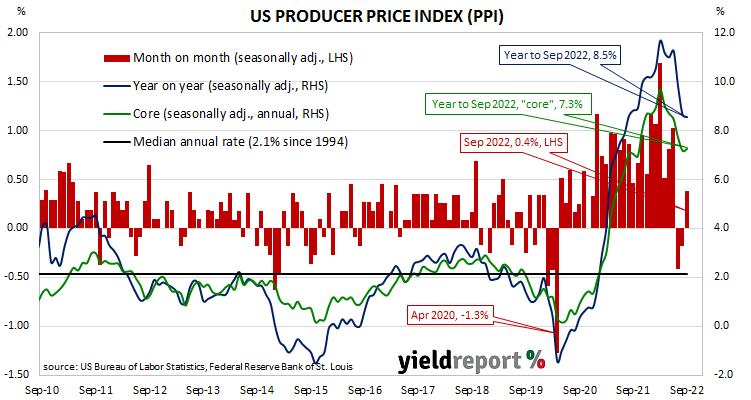Summary: US producer price index (PPI) up 0.4% in September, double expected figure; annual rate slows to 8.5%; “core” PPI up 0.3%; figures “little respite” from “strong inflation narrative”; “will put pressure on Fed to continue to aggressively hike rates”; Treasury yields decline, rate-rise expectations soften.
Around the end of 2018, the annual inflation rate of the US producer price index (PPI) began a downtrend which continued through 2019. Months in which producer prices increased suggested the trend may have been coming to an end, only for it to continue, culminating in a plunge in April 2020. Figures returned to “normal” towards the end of that year but annual rates through 2021 and 2022 have been well above the long-term average.
The latest figures published by the Bureau of Labor Statistics indicate producer prices increased by 0.4% after seasonal adjustments in September. The rise was double the 0.2% increase which had been generally expected and in contrast with August’s -0.2% after revisions. On a 12-month basis, the rate of producer price inflation after seasonal adjustments slowed from 8.6% in August to 8.5%.
Producer prices excluding foods and energy, or “core” PPI, rose by 0.3% after seasonal adjustments. The increase was in line with expectations as well as August’s rise. The annual rate accelerated slightly, from August’s revised figure of 7.2% to 7.3%.
Ray Attrill, NAB’s Head of FX Strategy within its FICC division said the figures “offered little respite from the strong inflation narrative…”
US Treasury bond yields generally declined on the day. By the close of business, 2-year and 10-year Treasury yields had each lost 3bps to 4.28% and 3.92% respectively while the 30-year yield finished unchanged at 3.91%.
In terms of US Fed policy, expectations of the path of the federal funds rate over the next 12 months generally softened. At the close of business, November contracts implied an effective federal funds rate of 3.765%, nearly 70bps higher than the current spot rate. December contracts implied 4.14% while September 2023 futures contracts implied an effective federal funds rate of 4.555%, almost 150bps above the spot rate.
“The ongoing strength in prices will put pressure on the Fed Reserve to continue to aggressively hike rates,” said ANZ economist Madeline Dunk.
The producer price index is a measure of prices received by producers for domestically produced goods, services and construction. It is put together in a fashion similar to the consumer price index (CPI) except it measures prices received from the producer’s perspective rather than from the perspective of a retailer or a consumer. It is another one of the various measures of inflation tracked by the US Fed, along with core personal consumption expenditure (PCE) price data.


